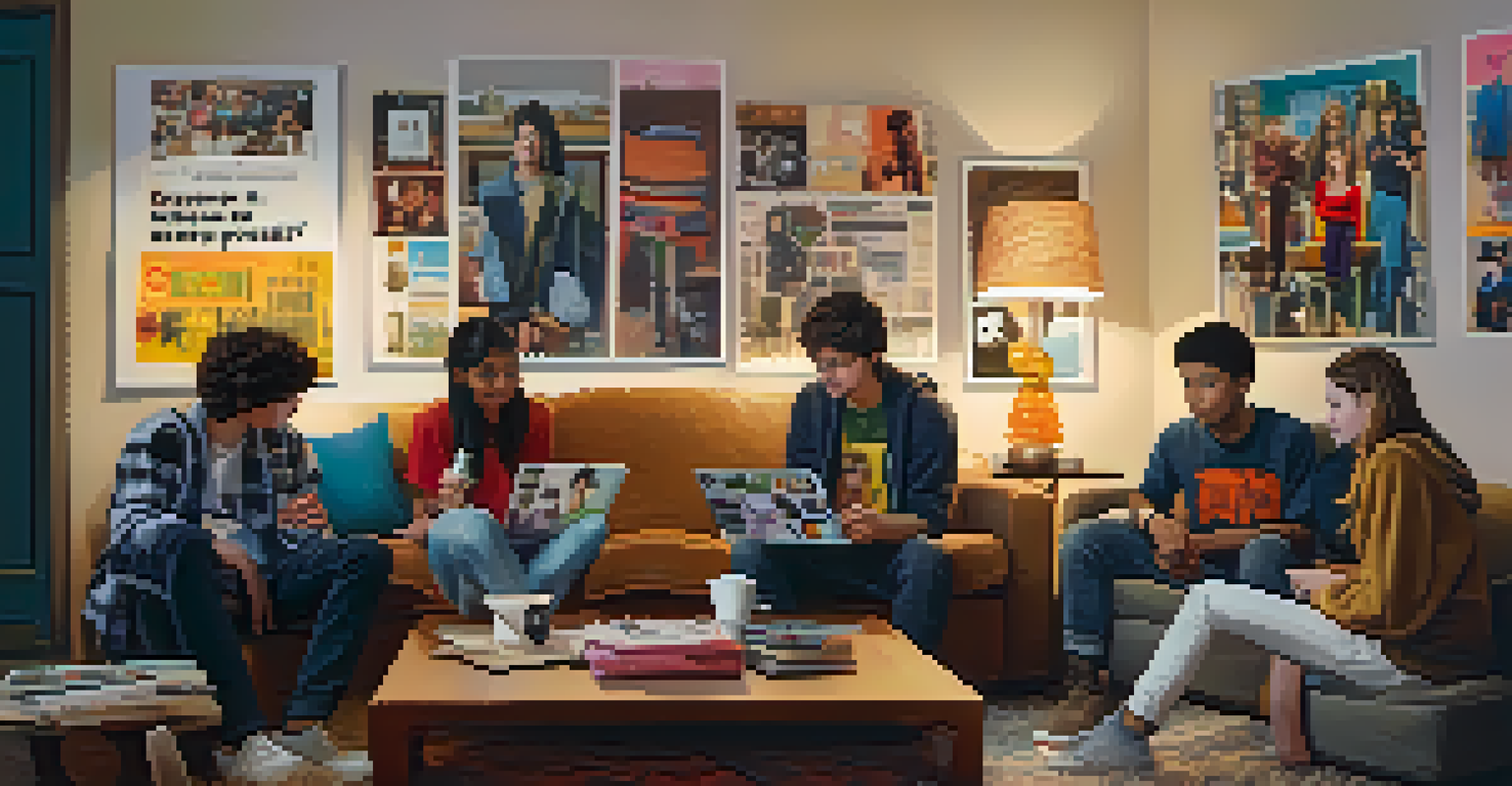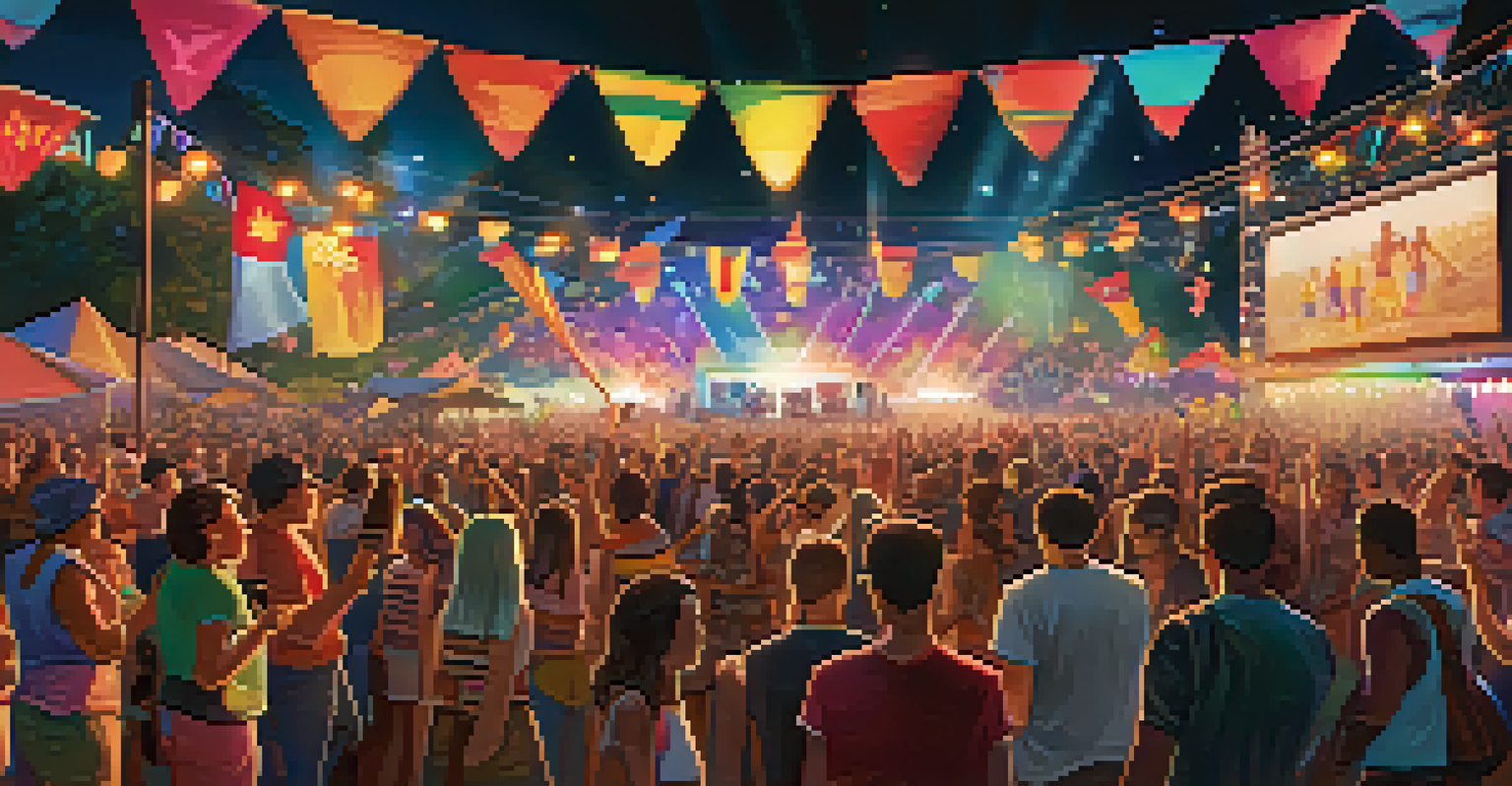Understanding Youth Subcultures Through Film Narratives

Defining Youth Subcultures in a Cinematic Context
Youth subcultures are groups formed by shared interests, values, and styles that often diverge from mainstream culture. They can include anything from punk rockers to hip-hop enthusiasts. Films frequently serve as a mirror, reflecting these unique identities and providing insight into the experiences of young people.
Films are a reflection of society, and they help us understand who we are and what we are capable of.
For instance, movies like 'The Breakfast Club' illustrate the diversity within high school cliques, representing the struggles and camaraderie of adolescence. This film encapsulates how different backgrounds shape youth experiences, highlighting the importance of belonging. Through such narratives, audiences gain a deeper understanding of the complexities surrounding youth culture.
By examining these depictions in film, we can better appreciate the rich tapestry of youth subcultures. They not only influence the film industry but also shape societal perceptions of young people. Understanding these narratives helps bridge the gap between generations and fosters empathy.
The Role of Film in Shaping Youth Identity
Films play a pivotal role in shaping the identities of youth by portraying relatable characters and scenarios. When young people see themselves reflected in film, it validates their experiences and emotions. This representation is crucial, as it allows them to explore their identities through the lens of characters navigating similar challenges.

Take 'Clueless,' for example; it offers an entertaining yet insightful look into the lives of affluent teenagers while exploring themes of friendship, self-discovery, and social status. Characters like Cher Horowitz resonate with audiences because they embody the struggle of finding one's place in a complex social landscape. Such portrayals can empower youth, encouraging them to embrace their unique identities.
Youth Subcultures Reflect Identity
Films portray youth subcultures, helping audiences understand the diverse experiences and identities of young people.
Moreover, film narratives often challenge stereotypes and present a more nuanced view of youth culture. By showcasing diverse backgrounds and experiences, filmmakers can dismantle misconceptions and foster understanding, making cinema a powerful tool for identity formation.
Exploring Themes of Rebellion and Acceptance
Rebellion is a common theme in youth subcultures, often depicted in films as a reaction against societal norms. Movies like 'Rebel Without a Cause' highlight the struggles of young people grappling with authority and the desire for acceptance. These narratives resonate deeply, as they reflect the internal conflicts many face during their formative years.
The cinema is a mirror of the world, and as the world is changing, cinema is changing too.
On the flip side, films also explore the theme of acceptance, portraying how youth navigate their search for belonging. In 'Mean Girls,' for example, the journey to find a place within the social hierarchy illustrates both the allure and pitfalls of fitting in. Through these stories, filmmakers shed light on the complicated dynamics of friendship and loyalty, which are essential to the youth experience.
Ultimately, the interplay between rebellion and acceptance is a defining characteristic of youth subcultures. Films that capture this complexity allow viewers to empathize with the characters' struggles, reinforcing the idea that these experiences are universal.
Cinematic Representations of Diverse Subcultures
Diversity in youth subcultures is often showcased in films, highlighting different backgrounds and lifestyles. From the vibrant world of skateboarding depicted in 'Lords of Dogtown' to the rich cultural narratives in 'Crazy Rich Asians,' filmmakers celebrate the unique experiences of various groups. This representation fosters inclusivity and encourages dialogue about cultural differences.
Films like 'Step Up' also illustrate how dance can transcend barriers, uniting individuals from various subcultures. Here, the characters come together through their passion for dance, emphasizing the power of art to bridge gaps and forge connections. Such narratives not only entertain but also educate audiences about the beauty of diversity.
Rebellion vs. Acceptance in Film
Many films explore the themes of rebellion and acceptance, illustrating the internal conflicts youth face in their search for belonging.
By showcasing a variety of subcultures, filmmakers can challenge stereotypes and promote understanding. These stories allow young viewers to see themselves in different contexts, broadening their perspectives and encouraging appreciation for others' experiences.
The Impact of Social Media on Youth Subcultures
In today’s digital age, social media significantly influences youth subcultures, and film narratives are adapting to reflect this change. Platforms like TikTok and Instagram allow young people to express their identities and connect with like-minded individuals globally. Films now often incorporate these elements, making them relevant to current youth culture.
For instance, films that feature social media as a central theme, like 'Eighth Grade,' highlight the pressures and challenges of growing up in the digital era. Characters navigate the complexities of online personas and real-life interactions, showcasing the impact of technology on their lives. This contemporary lens resonates with audiences who experience similar struggles.
Furthermore, social media can amplify the voices of youth subcultures, allowing underrepresented groups to share their stories. Filmmakers who embrace these narratives contribute to a richer understanding of youth experiences in a rapidly evolving landscape.
How Film Narratives Foster Empathy and Understanding
Film has the unique ability to foster empathy by immersing viewers in the lives of characters from diverse youth subcultures. Through storytelling, filmmakers invite audiences to walk in someone else's shoes, promoting understanding and compassion. This emotional connection is crucial in breaking down barriers and stereotypes.
For example, 'A Bronx Tale' presents the complex relationship between a father and son while exploring themes of race, class, and loyalty. By showcasing the struggles of its characters, the film encourages viewers to reflect on their own biases and assumptions. Such narratives challenge us to confront our perceptions of different cultures and lifestyles.
Social Media Shapes Youth Narratives
The rise of social media influences youth subcultures, prompting filmmakers to adapt narratives that resonate with modern experiences.
Ultimately, films that delve into youth subcultures nurture empathy by highlighting shared human experiences. They remind us that, despite our differences, we all grapple with similar feelings of love, loss, and the quest for identity.
The Future of Youth Subcultures in Film
As society continues to evolve, so too will the representation of youth subcultures in film. Emerging filmmakers are increasingly telling diverse stories that resonate with a broader audience, reflecting the changing landscape of youth culture. This shift opens the door for new narratives that challenge traditional portrayals and embrace a more inclusive perspective.
Moreover, technological advancements in filmmaking allow for innovative storytelling techniques. Virtual reality and interactive cinema enable audiences to engage with narratives in ways that were previously unimaginable. These developments can further immerse viewers in the lives of characters, deepening their understanding of youth subcultures.

As we look to the future, it's essential to continue supporting diverse voices in filmmaking. By championing these stories, we can ensure that the rich tapestry of youth experiences is represented on screen, fostering empathy and connection across generations.